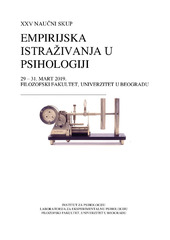| dc.description.abstract | In this study we focused on semantic ambiguity, namely, the difference between homonyms (multiple unrelated meanings) and polysemous words (multiple related senses). Previous research on processing effects of ambiguity found that polysemous words were processed faster, whereas homonymous were slower compared to unambiguous words (Rodd, Gaskell, & Marslen-Wilson, 2002). However, to the best of our knowledge, the ambiguity effect has never been researched in memory tasks. This study aimed to explore whether relatedness of meanings would have an effect on recall. Having in mind that the effects observed in processing tasks have a tendency to reverse in memory tasks, we predicted the similar reversal in our study. Such is the case with word frequency which facilitates word recognition, but makes the recall of the word harder (Lohnas & Kahana, 2013; Taft, 1979). Additionally, findings on the word processing facilitation by that word’s associates (Mayes, Montaldi & Migo, 2007) agree with our ambiguity effect reversal hypothesis. We therefore predicted that homonyms would show the highest recall, followed by unambiguous and ultimately polysemous words. We constructed a list containing 20 polysemes, 20 homonyms, and 20 unambiguous words that were randomly ordered. Four unambiguous fillers were presented at the beginning and the end of the list to control for the serial order effects. The list was presented to 30 participants in a free recall task. They were told that we are testing reading comprehension and that the task was to read the words carefully. The dependent variables were the percentage of a word recall (by-participant analysis) and the percentage of word group recall (by-stimuli). Two analyses were conducted using by-participant (F1) and by-item (F2) ANOVA. Homonyms were recalled the most, followed by unambiguous words, with polysemes being recalled the least (F1(2, 58) = 52.640, p < .001, η2 = .645; F2(2, 57) = 6.268, p < .003, η2 = .180). These results are congruent with our hypothesis, and point to the fact that ambiguity affects recall and that the meaning/sense relatedness plays a significant role in the process. When explaining these findings we must also consider temporal dynamics in semantics (Armstrong, 2012). Prolonged processing time allows all meanings of homonyms to achieve maximal activation of word representations, but also their associates during the time of the stimulus presentation, while simultaneously, the same effect decreases for polysemous words. | sr |

